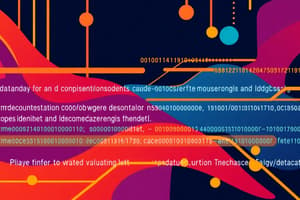Podcast
Questions and Answers
Which of the following best illustrates the relationship between data and information?
Which of the following best illustrates the relationship between data and information?
- Information is used to validate data, ensuring its accuracy.
- Data and information are interchangeable terms with no distinct difference.
- Data is processed to become information, providing context and meaning. (correct)
- Information is raw facts and figures, while data is the interpretation of those facts.
Which of the following is the best example of metadata?
Which of the following is the best example of metadata?
- A collection of customer addresses in a table.
- The average salary of employees in a department.
- A user's manual for a software application.
- A description of a field in a database table specifying its data type and size. (correct)
What is the primary advantage of using a database management system (DBMS) for managing data, compared to a file processing system?
What is the primary advantage of using a database management system (DBMS) for managing data, compared to a file processing system?
- Lack of centralized control of data.
- Improved data integration and reduced data redundancy. (correct)
- Increased data redundancy and isolation.
- Limited data sharing among different applications.
In a database environment, who is primarily responsible for maintaining the database and ensuring its integrity?
In a database environment, who is primarily responsible for maintaining the database and ensuring its integrity?
Which component of the database environment serves as a centralized storehouse of metadata?
Which component of the database environment serves as a centralized storehouse of metadata?
Consider a scenario where multiple applications need to access and modify the same data. Which of the following characteristics of a DBMS is most crucial in this situation?
Consider a scenario where multiple applications need to access and modify the same data. Which of the following characteristics of a DBMS is most crucial in this situation?
Which of the following database applications is designed to consolidate and analyze data from various sources within an organization to support decision-making?
Which of the following database applications is designed to consolidate and analyze data from various sources within an organization to support decision-making?
What is the most important consideration when choosing a DBMS for an application requiring 24/7 availability?
What is the most important consideration when choosing a DBMS for an application requiring 24/7 availability?
A company wants to implement a system that integrates all facets of the enterprise, including planning, manufacturing, sales, marketing, finance, human resources, and project management. Which type of database application is most suitable for this?
A company wants to implement a system that integrates all facets of the enterprise, including planning, manufacturing, sales, marketing, finance, human resources, and project management. Which type of database application is most suitable for this?
Which of the following factors contributes most to the need for database approaches to manage data?
Which of the following factors contributes most to the need for database approaches to manage data?
A social media platform needs to store and manage user profiles, posts, and relationships. Which of the following requirements is most critical for their database system?
A social media platform needs to store and manage user profiles, posts, and relationships. Which of the following requirements is most critical for their database system?
A business intelligence analyst needs to generate reports from a database. Which of the following capabilities of a DBMS is most relevant to this task?
A business intelligence analyst needs to generate reports from a database. Which of the following capabilities of a DBMS is most relevant to this task?
Which of the following describes the primary function of a Database Management System (DBMS)?
Which of the following describes the primary function of a Database Management System (DBMS)?
In the context of database management, why is program-data independence important?
In the context of database management, why is program-data independence important?
A small business is considering implementing a database system. Which of the following factors should they prioritize when selecting a DBMS?
A small business is considering implementing a database system. Which of the following factors should they prioritize when selecting a DBMS?
Flashcards
Data
Data
Stored representations of meaningful objects and events.
Information
Information
Data processed to increase knowledge in the person using the data.
Metadata
Metadata
Data that describes the properties and context of user data.
Database
Database
Signup and view all the flashcards
Database Approach
Database Approach
Signup and view all the flashcards
DBMS
DBMS
Signup and view all the flashcards
Repository
Repository
Signup and view all the flashcards
Database Management System (DBMS)
Database Management System (DBMS)
Signup and view all the flashcards
Data Administrators
Data Administrators
Signup and view all the flashcards
Application Programs
Application Programs
Signup and view all the flashcards
End Users
End Users
Signup and view all the flashcards
User Interface
User Interface
Signup and view all the flashcards
Personal Databases
Personal Databases
Signup and view all the flashcards
Two-Tier Client/Server Databases
Two-Tier Client/Server Databases
Signup and view all the flashcards
Multitier Client/Server Databases
Multitier Client/Server Databases
Signup and view all the flashcards
Study Notes
Important Concepts
- Data represents meaningful objects and events in a stored form
- Structured data includes numbers, strings, and dates
- Unstructured type includes images, video, and documents
- Information is the result of processing data to enhance knowledge
- Metadata describes the properties and context of user data
- A database is an organized, logically related data collection
Data
- A list of names and numbers satisfies the definition of data
- In this form, it is useless to use for most practical applications
- A class roster example provides context such as course, name, ID, major, and GPA
- Example metadata includes name, type, length, min, max, and description
- A graphical display can turn data into information useful for decision-makers.
Data Management in Real Life
- Needed by Facebook
- A platform with 2.74 billion monthly active users as of January 2021
- Users generate 4 million likes every minute and upload 355 million photos per day as of June 2019
- Facebook generates 4 petabytes (4 x 10^15 bytes) of data per day as of June 2019
Minimal Requirements
- Efficient to meet users demanding fast services
- Reliable, always available 24/7/365
- Secure to protect data
The Database Approach
- Focuses on a central repository of shared data
- Data are managed by a controlling agent, in a standardized and convenient form
- Requires a Database Management System (DBMS)
Database Management System (DBMS)
- A DBMS is a data storage and retrieval system.
- Data are stored non-redundantly.
- This makes data appear well-integrated to the user.
Components of the Database Environment
- Repository: Centralized storehouse of metadata
- Database: Storehouse of data
- Database Management System (DBMS): Software for managing databases
- Data Administrators: Responsible for maintaining the database
- CASE Tools: Computer-aided software engineering tools
- Application Programs: Software using the data
- System Developers: Personnel that are responsible for designing applications
- End Users: People who use the applications and databases
- User Interface: Text and graphical displays to users
DBMS Marketplace
- Enterprise DBMS:
- Oracle: Dominates in Unix. Strong in Windows
- Microsoft SQL Server: Strong in Windows
- DB2: Strong in mainframe environment
- Desktop DBMS:
- Access: Dominates
- OpenSource DBMS:
- MySQL: used by Apple, Sun, SAP, Dell, Intel and Novell
The Range of Database Applications
- Personal databases
- Two-tier Client/Server databases
- Multitier Client/Server databases
- Enterprise applications
- Enterprise resource planning (ERP) systems
- Data warehousing implementations
- Data Volume and expected number of users increase from Personal databases to Data Warehousing implementations
Evolution of Database Technologies
- Databases have evolved through flat files, hierarchical, network, relational, object-oriented, object-relational, and data warehousing models since 1960s
- Legacy systems are still in use today
Studying That Suits You
Use AI to generate personalized quizzes and flashcards to suit your learning preferences.




